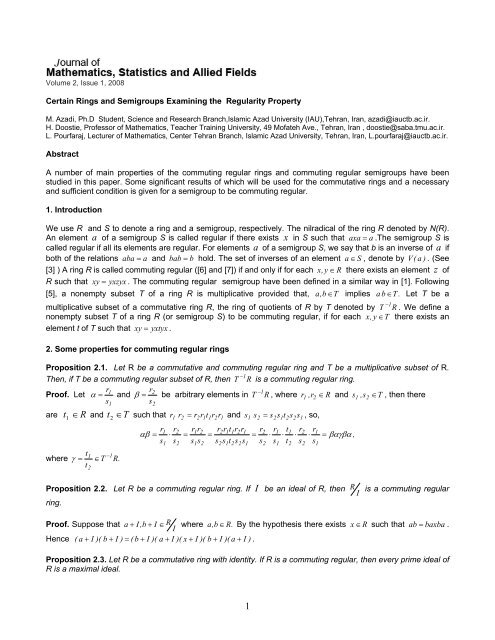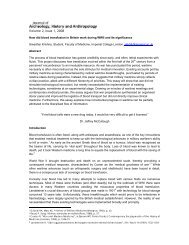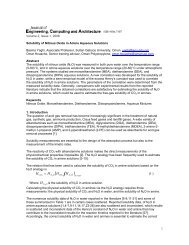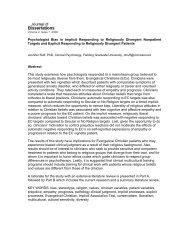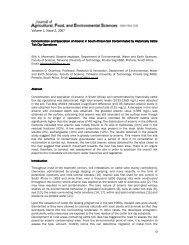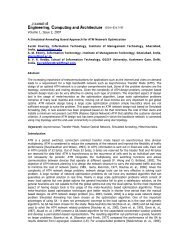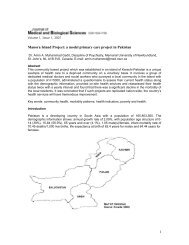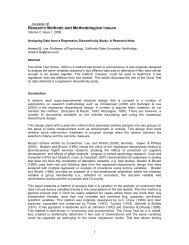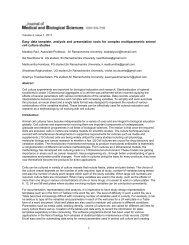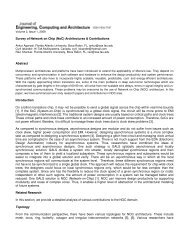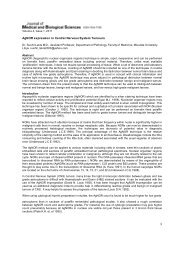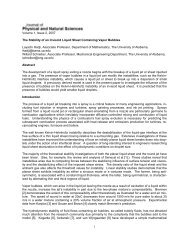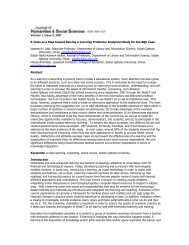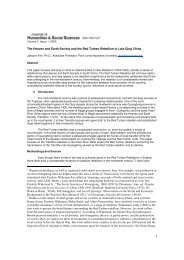Certain Rings and Semigroups Examining the Regularity Property ...
Certain Rings and Semigroups Examining the Regularity Property ...
Certain Rings and Semigroups Examining the Regularity Property ...
Create successful ePaper yourself
Turn your PDF publications into a flip-book with our unique Google optimized e-Paper software.
Volume 2, Issue 1, 2008<br />
<strong>Certain</strong> <strong>Rings</strong> <strong>and</strong> <strong>Semigroups</strong> <strong>Examining</strong> <strong>the</strong> <strong>Regularity</strong> <strong>Property</strong><br />
M. Azadi, Ph.D Student, Science <strong>and</strong> Research Branch,Islamic Azad University (IAU),Tehran, Iran, azadi@iauctb.ac.ir.<br />
H. Doostie, Professor of Ma<strong>the</strong>matics, Teacher Training University, 49 Mofateh Ave., Tehran, Iran , doostie@saba.tmu.ac.ir.<br />
L. Pourfaraj, Lecturer of Ma<strong>the</strong>matics, Center Tehran Branch, Islamic Azad University, Tehran, Iran, L.pourfaraj@iauctb.ac.ir.<br />
Abstract<br />
A number of main properties of <strong>the</strong> commuting regular rings <strong>and</strong> commuting regular semigroups have been<br />
studied in this paper. Some significant results of which will be used for <strong>the</strong> commutative rings <strong>and</strong> a necessary<br />
<strong>and</strong> sufficient condition is given for a semigroup to be commuting regular.<br />
1. Introduction<br />
We use R <strong>and</strong> S to denote a ring <strong>and</strong> a semigroup, respectively. The nilradical of <strong>the</strong> ring R denoted by N(R).<br />
An element a of a semigroup S is called regular if <strong>the</strong>re exists x in S such that axa = a .The semigroup S is<br />
called regular if all its elements are regular. For elements a of a semigroup S, we say that b is an inverse of a if<br />
both of <strong>the</strong> relations aba = a <strong>and</strong> bab = b hold. The set of inverses of an element a ∈ S , denote by V ( a ) . (See<br />
[3] ) A ring R is called commuting regular ([6] <strong>and</strong> [7]) if <strong>and</strong> only if for each x,<br />
y ∈ R <strong>the</strong>re exists an element z of<br />
R such that xy = yxzyx . The commuting regular semigroup have been defined in a similar way in [1]. Following<br />
[5], a nonempty subset T of a ring R is multiplicative provided that, a,b∈ T implies a b∈ T . Let T be a<br />
multiplicative subset of a commutative ring R, <strong>the</strong> ring of quotients of R by T denoted by T − 1 R . We define a<br />
nonempty subset T of a ring R (or semigroup S) to be commuting regular, if for each x,<br />
y ∈ T <strong>the</strong>re exists an<br />
element t of T such that xy = yxtyx .<br />
2. Some properties for commuting regular rings<br />
Proposition 2.1. Let R be a commutative <strong>and</strong> commuting regular ring <strong>and</strong> T be a multiplicative subset of R.<br />
Then, if T be a commuting regular subset of R, <strong>the</strong>n T −1<br />
R is a commuting regular ring.<br />
r1<br />
r2<br />
Proof. Let α = <strong>and</strong> β = be arbitrary elements in T − 1 R , where r1 ,r2<br />
∈ R <strong>and</strong> s1 ,s2<br />
∈ T , <strong>the</strong>n <strong>the</strong>re<br />
s1<br />
s2<br />
are t 1<br />
∈ R <strong>and</strong> t 2<br />
∈T<br />
such that r 1 r2<br />
= r2<br />
r1t<br />
1r2<br />
r1<br />
<strong>and</strong> s 1 s2<br />
= s2s1t2s2s1<br />
, so,<br />
t 1 − 1<br />
2<br />
where γ = ∈T<br />
R.<br />
t<br />
r1 r2<br />
r1r2<br />
r2<br />
r1t<br />
1r2<br />
r1<br />
r2<br />
r1<br />
t1<br />
r2<br />
r1<br />
αβ = ⋅ = = = ⋅ ⋅ ⋅ ⋅ = βαγβα ,<br />
s s s s s s t s s s s t s s<br />
1<br />
2<br />
1<br />
2<br />
2 1 2 2<br />
Proposition 2.2. Let R be a commuting regular ring. If I be an ideal of R, <strong>the</strong>n<br />
ring.<br />
1<br />
2<br />
1<br />
2<br />
2<br />
1<br />
R is a commuting regular<br />
I<br />
Proof. Suppose that a + I ,b + I ∈ R where a,b<br />
∈ R.<br />
By <strong>the</strong> hypo<strong>the</strong>sis <strong>the</strong>re exists x ∈ R such that ab = baxba .<br />
I<br />
Hence ( a + I )( b + I ) = ( b + I )( a + I )( x + I )( b + I )( a + I ) .<br />
Proposition 2.3. Let R be a commutative ring with identity. If R is a commuting regular, <strong>the</strong>n every prime ideal of<br />
R is a maximal ideal.<br />
1
Proof. Let P be a prime ideal of R, <strong>the</strong>n R is a commuting regular ring by <strong>the</strong> Proposition 2.2. If 0 ≠ a ∈ R ,<br />
P<br />
P<br />
<strong>the</strong>re exists R<br />
2 2 2<br />
2 2<br />
b∈ such that a = a ba <strong>and</strong> so a (1 − ba ) = 0 . Therefore 1 − ba 0<br />
P<br />
2 = or ba 2 −1<br />
= 1 <strong>and</strong> ba = a .<br />
So R is a field <strong>and</strong> P is a maximal ideal of R.<br />
P<br />
As a useful result of this Proposition we can see dim(R)=0.<br />
Proposition 2.4. Suppose that { Rα } α∈R<br />
is an arbitrary family rings with identity where, each Rα<br />
is commutative<br />
<strong>and</strong> commuting regular. Then N( R ) = N( R ).<br />
∏<br />
Proof. By <strong>the</strong> Proposition 3.1 of [1],<br />
by <strong>the</strong> Proposition 3.1 of [2], we get<br />
Recall <strong>the</strong> following definition from [2]:<br />
α∈I<br />
α<br />
∏<br />
α∈I<br />
α<br />
R = ∏ R α ∈ I α<br />
= ∏ ∈<br />
N( R<br />
α I α<br />
N( R )<br />
is commuting regular <strong>and</strong> by <strong>the</strong> Proposition 2.3, dimR=0. So,<br />
).<br />
Definition 2.5. Let R be a ring <strong>and</strong> x ∈ N( R ) . The integer η ( x ) = k is define to be <strong>the</strong> index of nilpotency of x ,<br />
k<br />
if x = 0 but x k − 1 ≠ 0 . Also, η ( R ) is defined to be sup{ η ( x ) : x ∈ N( R )} , if <strong>the</strong> set { η ( x ) : x ∈ N( R )} is<br />
bounded, <strong>and</strong> η ( R ) = ∞ , o<strong>the</strong>rwise.<br />
Theorem 2.6. Suppose that { Rα }<br />
α∈I<br />
is an arbitrary family of <strong>the</strong> commutative <strong>and</strong> commuting regular rings<br />
with identity. Then <strong>the</strong>re exists a positive integer k such that { α ∈:<br />
I : η(<br />
R ) > k } is finite.<br />
Proof. Let <strong>the</strong> assertion fails, <strong>the</strong>n <strong>the</strong>re is an infinite subset<br />
≠<br />
∈∏ ∈I<br />
∞<br />
{ i<br />
} 1<br />
α<br />
α of I <strong>and</strong> elements x N( R )<br />
α ∈ such that<br />
i α i<br />
i<br />
∞<br />
η ( xα<br />
) > i , so x 0<br />
i<br />
α<br />
. Let x = { x } N( R )<br />
i<br />
α α α , where x α = 0 if α ∈ I \ { α i } 1 . Clearly x { x i<br />
= α } ≠ 0 for<br />
each i <strong>and</strong> hence x ∉ N( ∏ ∈I<br />
( R ))<br />
α α <strong>and</strong> N( ∏ ( R )) ≠<br />
∈I<br />
∏ N( R )<br />
α α α∈I<br />
α . This contradicts 2.4.<br />
Proposition 2.7. Let R be a commuting regular ring with identity <strong>and</strong> P be an ideal in R. Then if P is prime<br />
<strong>the</strong>n for all a, b ∈ R , ab<br />
∈ P yields a∈ P or b ∈ P .<br />
Proof. Let P be a prime ideal <strong>and</strong> a,b<br />
∈ R such that a b∈ P.<br />
For an arbitrary element x ∈ R , <strong>the</strong>re exists an<br />
element t ∈ R such that abx = ( bx )at( bx )a ∈ bRa . So, abR ⊆ bRa . Also, for every bxa ∈ bRa , <strong>the</strong>re exists c ∈ R<br />
such that bxa = a( bx )ca( bx ) = ab( xcabx ) ∈ abR <strong>and</strong> <strong>the</strong>n bRa ⊆ abR . Consequently, bRa = abR ⊆ P which yields<br />
a∈ P or b ∈ P .<br />
Remark. Commuting regularity is necessary for <strong>the</strong> above Proposition.<br />
Proposition 2.8. Let e be an idempotent element of a ring R. If R is a commuting regular ring, <strong>the</strong>n<br />
a commuting regular ring with identity.<br />
R ′ = eRe is<br />
Proof. Clearly R′ is a ring with identity. Let exe <strong>and</strong> eye are arbitrary elements in R′ . Then <strong>the</strong>re are t 1 ,t2<br />
, t3<br />
<strong>and</strong> t<br />
4<br />
in R such that<br />
2
(exe)(eye) = e(xey)e = e(yxet<br />
= e(y(ext ex)t y(ext ex))e<br />
= eyex(t ext<br />
2<br />
2<br />
= eyex((et t et<br />
2 3<br />
yext<br />
yxe)e<br />
)exe<br />
= eyexe(t t et xt ext yt<br />
2 3<br />
1<br />
1<br />
2<br />
)xt (ext yt ext y))exe<br />
)(xt<br />
= (eye)(exe)(et e)(eye)(exe),<br />
where, t 5 = t2t3et2<br />
xt1ext2<br />
yt3xt2et4<br />
xt2<br />
.<br />
3. Some properties for commuting regular semigroups<br />
Recall <strong>the</strong> following definition from [3]:<br />
2<br />
5<br />
1<br />
2<br />
1<br />
1<br />
2<br />
2<br />
2<br />
3<br />
3<br />
2<br />
2<br />
et<br />
4<br />
xt<br />
2<br />
e)yexe<br />
Definition 3.1. A semigroup S is called a rectangular b<strong>and</strong> if<br />
aba = a for all a,<br />
b in S.<br />
Proposition 3.2. Let S be a rectangular b<strong>and</strong> semigroup. Then S is commutative if <strong>and</strong> only if S is commuting<br />
regular.<br />
Proof. Let S be commuting regular semigroup <strong>and</strong> a, b∈ S . So <strong>the</strong>re exists an element c ∈ S such that ab =<br />
bacba = ba , for, S is rectangular b<strong>and</strong>. Conversely, let S be a commutative semigroup, so ab = ba = bacba , for<br />
every c ∈ S .<br />
Recall <strong>the</strong> following definition from [3]:<br />
Definition 3.3. Let S be a semigroup. A relation R on <strong>the</strong> set S is called compatible if<br />
( ∀ s,t,a∈<br />
S) [ (s,t) ∈ R <strong>and</strong> (s′,t<br />
′)<br />
∈ R ] ⇒ (ss′,tt′)<br />
∈ R.<br />
A compatible equivalence relation is called congruence.<br />
S<br />
Let ρ be a congruence on a semigroup S <strong>and</strong> be <strong>the</strong> set of ρ -classes, whose elements are <strong>the</strong> subsets<br />
ρ<br />
S<br />
x ρ , <strong>the</strong>n we can define a binary operation on <strong>the</strong> quotient set , in a natural way as follows:<br />
ρ<br />
(a ρ )(b ρ ) = (ab) ρ.<br />
It is easy to check that ρ<br />
S <strong>and</strong> <strong>the</strong> above operation is a semigroup.<br />
Proposition 3.4. Let ρ be a congruence on commuting regular semigroup S. Then ρ<br />
S<br />
is a commuting regular<br />
semigroup.<br />
Proof. Let x, y ∈ S , so <strong>the</strong>re is c∈ S such that xy = yxcyx <strong>and</strong> <strong>the</strong>refore<br />
(x ρ )(yρ<br />
) = (xy) ρ = (yxcyx) ρ = (yρ<br />
)(x ρ )(cρ<br />
)(y ρ )( x ρ ).<br />
Thus S is commuting regular semigroup.<br />
Definition 3.5. Let S be a semigroup. The left map λ : S → S is called a left translation of S if λ (st) = ( λ s)t , for<br />
all s,t in S. The right map ρ : S → S is called a right translation of S if (st) ρ = s(tρ<br />
) , for all s,t in S. A left<br />
translation λ <strong>and</strong> a right translation ρ are said to be linked if s( λ t) = (s ρ ) t for all s t in S. The set of all linked<br />
pairs ( λ , ρ ) of left <strong>and</strong> right translation is called <strong>the</strong> translation hull of S <strong>and</strong> will be denoted by Ω (S) . Ω (S) is a<br />
semigroup under <strong>the</strong> obvious multiplication ( λ , ρ )( λ′ , ρ′<br />
) = ( λλ′<br />
, ρρ′<br />
) where λ λ′ denote <strong>the</strong> composition of <strong>the</strong><br />
left maps λ <strong>and</strong> λ′ , while<br />
ρ ρ′ .<br />
ρ ρ′ denotes <strong>the</strong> composition of <strong>the</strong> right maps<br />
3
Proposition 3.6. Let S be a commuting regular semigroup. For every a in S define λa s = as <strong>and</strong> s ρ a = sa<br />
(s ∈ S) . Then ( λ a , ρa<br />
) is a linked pair in Ω (S) <strong>and</strong> <strong>the</strong> set of every ( λ a , ρa<br />
) , where a∈ S , with multiplication of<br />
link translations is a commuting regular semigroup.<br />
Proof. It is easy to verify that, for all a,b in S, ( λ a , ρa<br />
)( λb<br />
, ρb<br />
) = ( λab<br />
, ρab<br />
) <strong>and</strong> <strong>the</strong> set of every ( λ a , ρ a ), with<br />
above multiplication, is a semigroup <strong>and</strong> if a, b∈ S , <strong>the</strong>n <strong>the</strong>re is t ∈ S such that ab = batba so<br />
λ , ρ )( λ , ρ ) = ( λ , ρ ) = ( λ , ρ ) = ( λ , ρ )( λ , ρ )( λ , ρ )( λ , ρ )( λ , ρ ) .<br />
( a a b b ab ab batba batba b b a a t t b b a a<br />
Proposition 3.7. Let S be a commuting regular semigroup with <strong>the</strong> set E of <strong>the</strong> idempotents. Then E is a<br />
regular subsemigroup of S. Moreover, for every element a of E , a∈ V(a).<br />
Proof. Suppose that a∈ S . There exists an element s∈ S such that a<br />
2 = 2 2<br />
a sa . If 2<br />
b = a s ,<br />
<strong>the</strong>n we get<br />
2 2 2 2 2 2<br />
b = (a s)(a s) = (a sa )s = a s = b,<br />
which shows that E is non empty. For elements x <strong>and</strong> y in E <strong>the</strong>re exists an element t of S such that<br />
xy = yxtyx . Hence,<br />
(xy) 2 = (xy)(yxtyx) = x(yy)xtyx<br />
= x(yxtyx) = x(xy) = (xx)y = xy.<br />
Consequently E is closed under <strong>the</strong> multiplication of <strong>the</strong> semigroup <strong>and</strong> x ⋅ x ⋅ x = x yields E is a regular<br />
subsemigroup of S, moreover, x∈ V(x) .<br />
Corollary 3.8. Let S be a commuting regular semigroup <strong>and</strong> a, b∈ S. Then a′ ea <strong>and</strong> ae a′ are idempotents, for<br />
every a′ ∈V(a)<br />
<strong>and</strong> e∈ E , where, E is <strong>the</strong> set of idempotents of S.<br />
Proof. For every a′ ∈V(a)<br />
, (a a ′)(aa′)<br />
= (aa′<br />
a)a′<br />
= aa′<br />
. Considering <strong>the</strong> Proposition 3.7 we get eaa′ ∈ E <strong>and</strong>,<br />
2<br />
(a′<br />
ea)(a′<br />
ea) = (a′<br />
ea)(a′<br />
e)(aa′<br />
a) = a ′(eaa′)<br />
a = a′<br />
eaa′<br />
a = a′<br />
ea.<br />
We use a similar proof to show that ae a′ is idempotent.<br />
Theorem 3.9. Let S be a commuting regular semigroup with <strong>the</strong> set E of <strong>the</strong> idempotents. Let<br />
a, b ∈ S . We define <strong>the</strong> set S(e, f) , by<br />
S(e, f) = { g ∈V(ef)<br />
I E : ge = fg = g }.<br />
Then, S(e, f) is a regular subsemigroup of S.<br />
e , f ∈ E <strong>and</strong><br />
Proof. By <strong>the</strong> commuting regularity of S, <strong>the</strong>re exists an element<br />
(ef) 2 = (fetfe)ef = fetf(ee)f = (fetfe)f = (ef)f = e(ff) = ef,<br />
2<br />
ef(ef)ef = ef(ef)<br />
= ef ef = ef,<br />
t ∈ S such that ef = (fe)t(fe). Then,<br />
(ef)e = (fetfe)e = fetf(ee) = fetfe = ef,<br />
f(ef) = f(fetfe) = (ff)(etfe) = fetfe = ef.<br />
This yields, ef ∈ S(e, f) <strong>and</strong> S(e, f) ≠ φ . Let x, y ∈ S(e, f) . So <strong>the</strong>re exists an element u ∈ S such that<br />
xy = yxuyx (for, S is commuting regular.) Then,<br />
(xy) 2 = xy(yxuyx) = x(yy)xuyx = x(yxuyx) = x(xy) = xxy = xy,<br />
ef(xy)ef = ef(xe)(fy)ef = (efxef)(yef) = efyef = ef,<br />
xy(ef)xy = x(ye)(fx)y = xyxy = xy.<br />
4
Hence, xy ∈ V(ef) I E . On <strong>the</strong> o<strong>the</strong>r h<strong>and</strong>, (xy)e = x(ye) = xy, f(xy) = (fx)y = xy . Let S(e, f)<br />
2 =<br />
(xe)(fx) = x x. This shows that, S(e, f) is a regular subsemigroup of S.<br />
x ∈ , <strong>the</strong>n x(ef)x =<br />
Proposition 3.10. Let S be a commuting regular semigroup <strong>and</strong><br />
b′ ∈V(b) , a′ ∈V(a)<br />
<strong>and</strong> g ∈ S(a′<br />
a,bb′<br />
).<br />
a, b ∈ S . Then, b′ g a′<br />
∈V(ab)<br />
, for every,<br />
Proof. Let b′ ∈V(b),<br />
a′<br />
∈V(a)<br />
<strong>and</strong> g ∈ S(a′<br />
a,bb′<br />
) . So,<br />
ab(b′<br />
ga ′)ab<br />
= (aa′<br />
a)(bb ′)ga′<br />
a(bb′<br />
b)<br />
= a(a′<br />
abb′<br />
ga′<br />
abb ′)b<br />
= a(a′<br />
abb ′)b<br />
(for, g ∈S(a′<br />
a,bb ′))<br />
= (aa′<br />
a)(bbb) = ab.<br />
And also,<br />
( b′<br />
ga ′)(ab)(b′<br />
g a ′)<br />
= b ′(g(a′<br />
abb ′)g)a′<br />
= b′<br />
ga′<br />
(for, g ∈ S(e, f)).<br />
Consequently b′ ga′<br />
∈V(ab)<br />
.<br />
Corollary 3.11. Let S be a commuting regular semigroup <strong>and</strong><br />
a,b ∈ S . Then V(b)V(a)⊆ V(ab) .<br />
2<br />
Proof. Let b′ ∈V(b)<br />
<strong>and</strong> a′ ∈V(a)<br />
. So, (a′ a) = a′<br />
a , (bb′) 2 = bb′<br />
<strong>and</strong><br />
b ′ a′<br />
= (b′<br />
bb ′)(a′<br />
aa ′)<br />
= b ′(bb′<br />
a′<br />
a)a ′.<br />
Then, by <strong>the</strong> Theorem 3.9 we get b b′ a′<br />
a ∈S(a′<br />
a,bb′<br />
) . We now get b′ a′<br />
∈V(ab)<br />
by using <strong>the</strong> Proposition 3.10.<br />
Proposition 3.12. Let S be a commuting regular semigroup with <strong>the</strong> set E of <strong>the</strong> idempotents. Then V(e) ⊆ E ,<br />
for every e in E .<br />
Proof. Let x ∈ V(e) . Then xex = e <strong>and</strong> exe = x . Since xe <strong>and</strong> ex are both idempotent elements <strong>the</strong>n, each one is<br />
its inverse (as semigroup element). By <strong>the</strong> corollary 3.11, (ex)(xe) is an inverse of (xe)(ex), that is to say ex 2 e is<br />
an inverse of xe 2 2<br />
2 2<br />
x = xex = x . Consequently, x = x(ex e)x = (xex) = x . This shows that x∈ E .<br />
4. Green's Equivalences <strong>and</strong> commuting regularity<br />
Firstly, we recall <strong>the</strong> following definitions from [2]:<br />
Definition 4.1. If a is an element of a semigroup S, <strong>the</strong> smallest left ideal of S containing a is Sa U {a } <strong>and</strong><br />
denoted by S 1 1 1<br />
a . An equivalence L on S is define by <strong>the</strong> rule that a L b if <strong>and</strong> only if S a = S b . Similarly, we<br />
1 1<br />
define <strong>the</strong> equivalence R by <strong>the</strong> rule that aRb<br />
if <strong>and</strong> only if aS = bS .<br />
Proposition 4.2. Let a <strong>and</strong> b are elements of a semigroup S. Then<br />
1<br />
S such that<br />
xa = ba <strong>and</strong> yb = a . Also, a R b if <strong>and</strong> only if <strong>the</strong>re exist u <strong>and</strong> v in<br />
Proof. See [3], Proposition 2.1.1.<br />
Proposition 4.3. The relations L <strong>and</strong> R commute.<br />
Proof. See [3], Proposition 2.1.2.<br />
Proposition 4.4. Let S be a commuting regular semigroup <strong>and</strong><br />
a L b if <strong>and</strong> only if <strong>the</strong>re exist x <strong>and</strong> y in<br />
1<br />
S such that au = b , bv = a.<br />
a, b∈ S . Then a L b if <strong>and</strong> only if aR b .<br />
5
Proof. Suppose that a L b . By <strong>the</strong> Proposition 4.2, <strong>the</strong>re are x <strong>and</strong> y in S such that xa = ba <strong>and</strong> yb = a . So,<br />
<strong>the</strong>re are t 1 , t2<br />
in S such that<br />
a = xa = axt2 ax = ux , b = yb = byt2by<br />
= vy,<br />
where, u = axt1a<br />
<strong>and</strong> v = byt2b<br />
. Now, using <strong>the</strong> last part of <strong>the</strong> Proposition 4.2 gives us aR b . Proof of <strong>the</strong><br />
converse is Similar.<br />
We define <strong>the</strong> equivalence D by<br />
D = L o R = R o L.<br />
The equivalence D is a two-sided analogue of L <strong>and</strong> R . Also we define <strong>the</strong> equivalence I by <strong>the</strong> rule aIb<br />
if<br />
1 1 1 1<br />
1<br />
<strong>and</strong> only if S aS = S bS , that is, if <strong>and</strong> only if <strong>the</strong>re exist x , y, u <strong>and</strong> v in S such that xay = b , ubv = a.<br />
It is immediate that L ⊆ I <strong>and</strong> R ⊆ I . Hence, since D is <strong>the</strong> smallest equivalence containing L <strong>and</strong> R , we<br />
get D ⊆ I .<br />
Proposition 4.5. If S is a commuting regular semigroup, <strong>the</strong>n<br />
D = I .<br />
Proof. It is enough to show I ⊆ D . For elements a <strong>and</strong> b in S let aI b . Then, <strong>the</strong>re are x , y, u <strong>and</strong> v in<br />
such that<br />
xay = b , ubv = a.<br />
So, <strong>the</strong>re exists an element t<br />
1<br />
in S such that<br />
a = ubv = u(xay)v = (yv)(uxa)t1(yv)(uxa)<br />
= w1c,<br />
where, w1 = yvuxat1<br />
yvu <strong>and</strong> c = xa , i.e., a L c (by <strong>the</strong> Proposition 4.2). Combining <strong>the</strong> relations xay = b <strong>and</strong><br />
c = xa we get cy = b . Then <strong>the</strong>re exists an element t 2 ∈ S such that<br />
where,<br />
c = xa = x(ubv) = (xu)(bv) = (bv)(xu)t2(bv)(xu)<br />
= bw2<br />
,<br />
2 = vxut bvxu . This shows that cR b . Then I ⊆ D .<br />
w 2<br />
5. Conclusions.<br />
Commuting regularity is defined basically for non-commutative rings. Generalizing this property for semigroups<br />
<strong>and</strong> getting necessary <strong>and</strong> sufficient condition for a semigroup to be commuting regular was <strong>the</strong> main purpose of<br />
this paper.<br />
References<br />
[1] H. Doostie, L. Pourfaraj, (2006). On <strong>the</strong> minimal ideals of commuting regular rings <strong>and</strong> semigroups, Internat.<br />
J. Appl. Math. 19, No. 2, 201-216.<br />
[2] R. Gilmer, W. Heinzer, (1992). Products of commutative rings <strong>and</strong> zero-dimensionally, Trans. of <strong>the</strong> Amer.<br />
Math. Soc. Vol. 331, No. 2, 663-679.<br />
[3] J. M. Howie, (1995). Fundamentals of semigroup Theory, Clarendon Press. Oxford, New York (1995).<br />
[4] J. M. Howie, (1976). An Introduction to Semigroup Theory , Academic Press, London.<br />
[5] T. W. Hungerford, (1974). Algebra, New York. Holt, Rinehart <strong>and</strong> Winston, Springer-Verlag.<br />
[6] Sh. A. Safari Sabet, (2004). Commutativity conditions for rings with unity, Internal. J. Appl. Math. 15, No. 1,<br />
9-15.<br />
[7] Amir. H. Yamini, Sh. A. Safari Sabet, (2003). Commuting regular rings, Internal. J. Appl. Math. 14, No. 4,<br />
3557-3364.<br />
1<br />
S<br />
6


